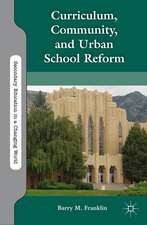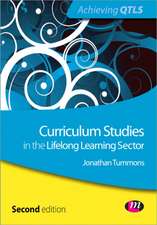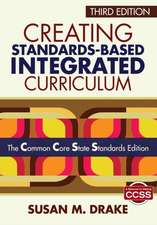The Parallel Curriculum in the Classroom, Book 1: Essays for Application Across the Content Areas, K-12
Editat de Carol Ann Tomlinson, Sandra N. Kaplan, Jeanne H. Purcell, Jann H. Leppien, Deborah E. Burns, Cindy A. Stricklanden Limba Engleză Paperback – 19 oct 2005
| Toate formatele și edițiile | Preț | Express |
|---|---|---|
| Paperback (1) | 312.68 lei 6-8 săpt. | |
| SAGE Publications – 19 oct 2005 | 312.68 lei 6-8 săpt. | |
| Hardback (1) | 480.89 lei 6-8 săpt. | |
| SAGE Publications – 19 oct 2005 | 480.89 lei 6-8 săpt. |
Preț: 312.68 lei
Nou
Puncte Express: 469
Preț estimativ în valută:
59.83€ • 62.65$ • 49.63£
59.83€ • 62.65$ • 49.63£
Carte tipărită la comandă
Livrare economică 10-24 aprilie
Preluare comenzi: 021 569.72.76
Specificații
ISBN-13: 9780761929727
ISBN-10: 076192972X
Pagini: 128
Dimensiuni: 216 x 279 x 8 mm
Greutate: 0.37 kg
Ediția:1
Editura: SAGE Publications
Colecția Corwin
Locul publicării:Thousand Oaks, United States
ISBN-10: 076192972X
Pagini: 128
Dimensiuni: 216 x 279 x 8 mm
Greutate: 0.37 kg
Ediția:1
Editura: SAGE Publications
Colecția Corwin
Locul publicării:Thousand Oaks, United States
Recenzii
"These essays help educators think more fully and deeply about the PCM model, about the curriculum development process, and about the students who would benefit from a rich, multifaceted, expert-oriented curriculum."
—From Book 1
—From Book 1
Cuprins
Introducing the Parallel Curriculum Model in the Classroom by Carol Ann Tomlinson and Sandra Kaplan
About the Book
Using the Model and Units for Professional Development
Acknowledgments
1. In Praise of Protocols: Navigating the Design Process Within the Parallel Curriculum Model by Deborah E. Burns
Curriculum as a Road Map
The Purpose, Problems, and Process of Curriculum Writing
The Goal and Sequence of This Essay
The Beginning: Agreeing on the Components of a Curriculum Plan
The Challenge of Writing Well-Aligned PCM Curriculum
Supporting the Work of Creative Professionals
The Parallel Curriculum Model Protocols
Conclusion
2. The Importance of the Focusing Questions in Each of the Curriculum Parallels by Jann H. Leppien
The Nature of a Discipline and How It Relates to the Focusing Questions
Early in the Curriculum Planning Process
Using the Core Curriculum’s Purpose, Characteristics, and Questions to Guide Curricular Decisions
Using the Curriculum of Connections’ Purpose, Characteristics, and Questions to Guide Curricular Decisions
Using the Curriculum of Practice’s Purpose, Characteristics, and Questions to Guide Curricular Decisions
Using the Curriculum of Identity’s Purpose, Characteristics, and Questions to Guide Curricular Decisions
In Closing
3. Using the Four Parallel Curricula as a Comprehensive Curriculum Model: Philosophy and Pragmatism by Sandra N. Kaplan
The Philosophical Rationale
The Pragmatic Rationale
Conclusion
4. Exploring the Curriculum of Identity in the PCM Model by Jeanne Purcell
What Is the Curriculum of Identity?
What’s In It for Me?
Conclusion
References
5. Ascending Intellectual Demand Within and Beyond the Parallel Curriculum Model by Carol Tomlinson, Sandra Kaplan, and Kelly Hedrick
What Is Ascending Intellectual Demand?
How Does Ascending Intellectual Demand Relate to Other Guides for Challenge?
How Is Ascending Intellectual Demand Different Than Other Approaches to Challenge?
Using Ascending Intellectual Demand to Plan Curriculum and Instruction
When and Where Do Teachers Apply Ascending Intellectual Demand?
A Word of Caution
Why Does Ascending Intellectual Demand Matter?
References
Index
About the Book
Using the Model and Units for Professional Development
Acknowledgments
1. In Praise of Protocols: Navigating the Design Process Within the Parallel Curriculum Model by Deborah E. Burns
Curriculum as a Road Map
The Purpose, Problems, and Process of Curriculum Writing
The Goal and Sequence of This Essay
The Beginning: Agreeing on the Components of a Curriculum Plan
The Challenge of Writing Well-Aligned PCM Curriculum
Supporting the Work of Creative Professionals
The Parallel Curriculum Model Protocols
Conclusion
2. The Importance of the Focusing Questions in Each of the Curriculum Parallels by Jann H. Leppien
The Nature of a Discipline and How It Relates to the Focusing Questions
Early in the Curriculum Planning Process
Using the Core Curriculum’s Purpose, Characteristics, and Questions to Guide Curricular Decisions
Using the Curriculum of Connections’ Purpose, Characteristics, and Questions to Guide Curricular Decisions
Using the Curriculum of Practice’s Purpose, Characteristics, and Questions to Guide Curricular Decisions
Using the Curriculum of Identity’s Purpose, Characteristics, and Questions to Guide Curricular Decisions
In Closing
3. Using the Four Parallel Curricula as a Comprehensive Curriculum Model: Philosophy and Pragmatism by Sandra N. Kaplan
The Philosophical Rationale
The Pragmatic Rationale
Conclusion
4. Exploring the Curriculum of Identity in the PCM Model by Jeanne Purcell
What Is the Curriculum of Identity?
What’s In It for Me?
Conclusion
References
5. Ascending Intellectual Demand Within and Beyond the Parallel Curriculum Model by Carol Tomlinson, Sandra Kaplan, and Kelly Hedrick
What Is Ascending Intellectual Demand?
How Does Ascending Intellectual Demand Relate to Other Guides for Challenge?
How Is Ascending Intellectual Demand Different Than Other Approaches to Challenge?
Using Ascending Intellectual Demand to Plan Curriculum and Instruction
When and Where Do Teachers Apply Ascending Intellectual Demand?
A Word of Caution
Why Does Ascending Intellectual Demand Matter?
References
Index
Descriere
Further developing key ideas from the highly acclaimed original book, these essays include guidelines for designing curriculum units based on the Parallel Curriculum Model.
















